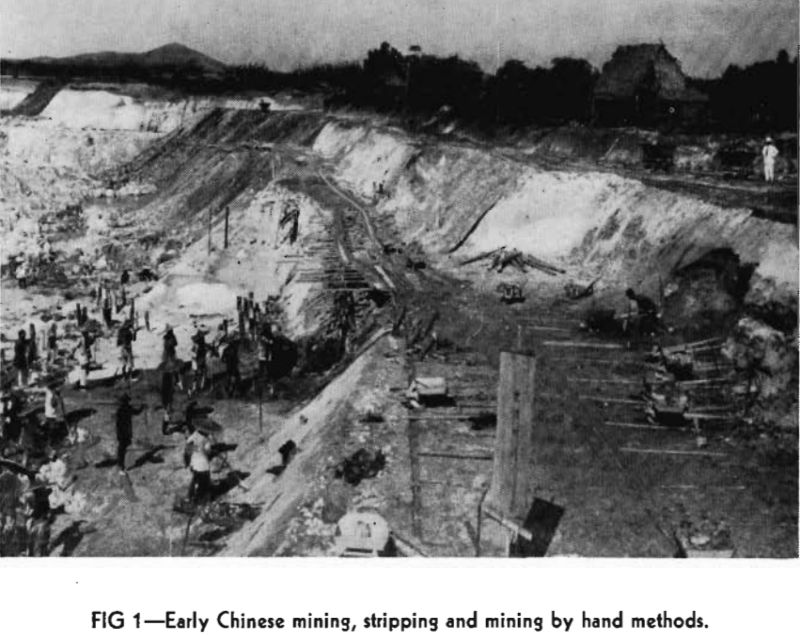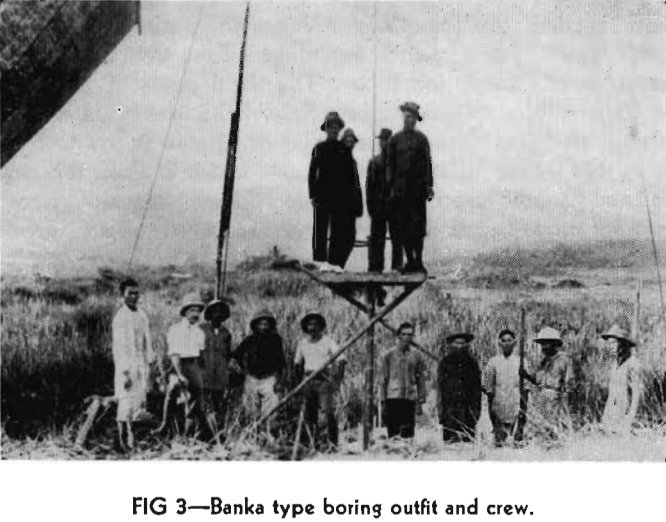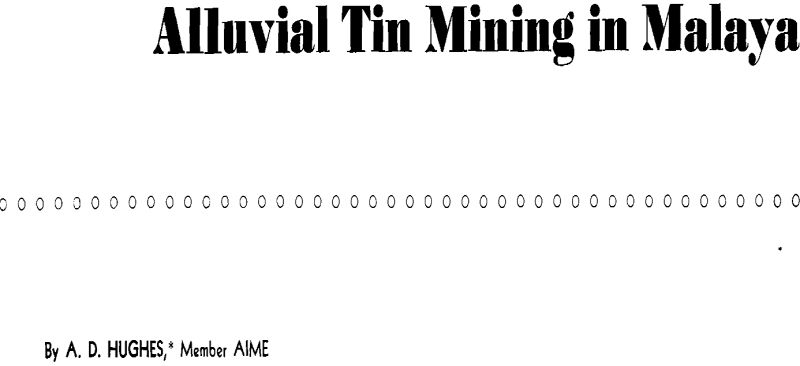Table of Contents
A relatively small area in Malaya, about 200 miles long by 40 miles wide, is the most important source of tin in the world. Some tin is recovered in other parts of the peninsula. Of the tin mined, 98 pct is recovered from alluvial deposits. From 1935 to 1941 the average annual world production of tin was 190,000 tons. The average annual production from Malaya during the same period was 62,000 tons or about one third of the total. Other producing countries, in order of importance, were the Netherlands East Indies 34,000 tons, Bolivia 30,000, Belgian Congo, Nigeria, Siam, Burma, China, and a few others with smaller amounts. The serious shortage of tin during the war period was due to the fact that the Japanese were occupying Malaya, Netherlands East Indies, Siam, Burma, and China which, together, formerly were producing 65 pct of the world supply.


History
Some tin was mined in Malaya prior to 1500. When the Portugese captured Malacca at about that time, the Malays were using a tin coinage. When the Dutch captured Malacca from the Portugese about 1640, trading stations to control the tin trade were found near the mouths of the rivers. For 200 years very little development was accomplished. There was some fighting between the Siamese and Malays for control. Later, Chinese immigrated to the country and became active in tin mining. Fighting among the Chinese factions led to the intervention of the British in 1873. Order was established and many more Chinese immigrated in subsequent years.
The first British tin mining company was formed in 1892 to carry on open cast mining. It was not until 1912 that the first dredge was installed. Development has been rapid since that time. By December 1941, when war broke out in the Far East, 127 dredges had been constructed in Malaya of which 104 were then in operation. In addition there were over 700 mines operated by machinery and 150 smaller operations.
Ore Occurrence
The main physiographical feature of the country is the granite range of mountains which extends some 300 miles long and 40 miles wide in a north-south direction near the western side of the peninsula. The crest of this range is from 4000 to 7000 ft in height. The tin deposits of Malaya are associated with the granite. To the west the granite is in contact with limestone, and it is along this contact that the richest deposits were formed. Further west, shales are the pre-dominant bedrock.
It is the erosion of the granite and the contact zones which accounts for the extensive alluvial deposits. In most of the area the granite-limestone contacts are “frozen,” but a few very rich contact deposits have been found and worked extensively by open pit methods. In some areas small stringers carrying tin ore have been found in the granite but no extensive lodes have been found in it to date. There is one large lode mine near the east coast, over 200 miles from the main placer deposits where the tin ore occurs in quartz veins in schist. To date this is the only large scale lode mine in the country.
To date no oil has been found and all petroleum products are imported.

Prospecting
Practically all prospecting, both by European companies and the Chinese miners, is done with the Banka type drills. This is because such equipment is transported easily and this is important as much of the potential mining areas are swampy. It would be impracticable to transport heavy drilling equipment such as a Keystone drill over most of the areas.
The Banka type drills consist of heavy 4 in. pipe, with sleeve couplings, the pipe being made up in 5-ft. lengths. The cutting shoes are about 5 in. in diameter. Clamps with long extensions are placed near the top of the pipe. A wooden platform is placed on the clamps and four men mount the platform. 1 1/8 in. square rods in 10-ft lengths, with male and female thread couplings, are used. As most of the deposits are sand and clay, most of the drilling is done with the pumps. These are 4-ft lengths of 3-in. pipe with a replaceable shoe and clapper valve at one end and a bail with male threads to fit the rods at the other end. Other drilling tools are an auger for use in stiff clay and a chisel bit for use when rocks or wood are encountered.
When the pump is filled, it is raised to the collar of the hole, the rods being disconnected in turn and the pump is dumped into a sample box on the

ground. In ground averaging 60 to 70 ft deep, normal progress for a drill crew is 50 ft per shift. In deeper ground the progress is slower as the weight of the rods increases and more time is consumed in connecting and disconnecting the rods and pumps. The crews, usually Chinese, are hired through one man in groups of eight.
Dredging Conditions
Dredging conditions vary considerably throughout the area. In general, however, the material being dredged is sand with some fine gravel with varying amounts of clay. There is very little coarse gravel as known here in California. Near the granite contact the deposits are generally underlaid by limestone bedrock and contain more clay than those further away underlaid by shale bedrock. They are largely the result of decomposition of the granite and consist of quartz sand and clay, the clay being the result of decomposition of the feldspar. Some deposits near the contact are “in situ” and are simply decomposed granite with a stock work of small veins.
The limestone bedrock presents real dredging problems as it is often very irregular, consisting of pinnacles and crevices. In a dredging area which boring shows to have an average depth of 60 to 70 ft there may be pinnacles extending nearly to the surface. Often these are not found in prospecting but are encountered in the course of dredging. In many cases it has been necessary to drill and blast the tops of these pinnacles in order to provide safe flotation for the dredges. Depths of digging in one face may vary from just a few feet to maximum depth. Obviously all of the tin ore cannot be recovered by dredging in this type of deposit.
Dredging Equipment
As mentioned in the preliminary remarks, there were 104 dredges in active operation in Malaya in 1941 when the Japanese over-ran the country. Practically all were of steel construction. Generally speaking, the digging end of the tin dredges is similar to that of the gold dredges in this country. The difference is in the treatment of the material on board to

recover the values.
The dredges vary greatly in design, size, and efficiency. Bucket sizes vary from 6 to 18 cu ft, and digging depths from about 35 to 125 ft below water. They all operate on head lines instead of spuds as is usual in the United States. This is due to the fact that the fine material does not afford sufficient backing for spuds.
Dredges as described above, may be considered the standard type. They dig the material which is then discharged through the hopper to a revolving screen. The undersize from the screen is distributed to the jigs, and the oversize is discharged aft of the dredge as tailing. In deposits containing large percentages of clay, special equipment has been developed.
In deposits of this type, the first difficulty to be overcome was the emptying of the buckets. This was accomplished by changing the design of the buckets to a bowl shape, and introducing a clay extractor just aft of the upper tumbler. This consists of three wide blades about 3 ft long attached to a shaft at equal intervals. No power is applied to the shaft, which is held in position by three sided cams. As a bucket passes over the upper tumbler, a blade enters the bucket just inside the lip. The continued progress of the bucket forces the blade into the bucket where it scoops out the contents, and the next blade is brought into position to enter the next bucket. The clay extractor is suspended so that it can be moved back out of service when it is not required.
Operating Methods
The dredges are usually built in artificial pits. The hull ordinarily is built on posts but some are launched. When the hull is complete and afloat, the superstructure and machinery are installed. The dredge is then put into operation and the cut is deepened as rapidly as possible and widened to the desired width. General practice is to carry cuts as wide as possible and widths of 1500 to 2000 ft are common.
As the material is dug by the buckets, it is discharged to a hopper, from which it passes to a revolving screen 7 to 9 ft in diameter, 40 to 60 ft long, equipped with screen plates with 3/8-in. holes. Water to wash the material is introduced into the screen. On what may be called the normal dredge, without special clay treating equipment, the oversize from the screen is discharged aft through a chute. The undersize is distributed to rougher jigs installed on each side of the dredge. Four-cell jigs with beds about 42 in. square are used almost universally. The jig bedding is hematite, screened to ½ in. size, iron punchings or coarse tin ore. The jig screens have slotted holes 1/16 to 1/12 in. in width. Rougher jigs are operated at 80 to 100 strokes per minute with a 1 to 1¼ in. stroke. The concentrate from the rougher jigs is carried by launder to cleaner jigs. These are 4-cell jigs, usually operated at a somewhat faster rate and with shorter stroke.
The concentrate taken ashore is transported to a tin shed for further cleaning. If the concentrate contains pyrite or arsenopyrite, as is often the case, it is roasted before further washing. The final cleaning of the ore is done by expert Chinese tin washers on contract. The concentrate is washed first in short sluices to remove the lighter impurities and then, finally, cleaned by hand jigging in screens about 10 in. in diameter. Some mechanical aids such as hindered settling devices and magnetic separators are used by some companies, but a very large proportion of the operation is by hand.
Chinese Gravel Pump Mining
As mentioned before, the Chinese did the first extensive tin mining in Malaya. At that time the work was done largely by hand with very primitive equipment. During the course of the several years before the war, they developed a method of mining by gravel pumps which is now almost universal with them (Fig 6). The method may be described as follows: water, either from a near by stream or as return from the tailing area, is led to a fresh water pump near the mine. This pump acts as a booster pump to develop pressure. The water is led to three or four small monitors with about 3 in. nozzles, set in the pit. The water is played against the banks and washes the material down to a sump.
It is usually necessary to impound the tailings. This is accomplished, in some cases, by depositing them in a former pit, and in other cases by impounding them on level ground. The method is to throw up a small levee around sufficient area As the material is deposited, two or three men, using a tool like a hoe, keep raising the levee, so that it is kept about a foot above the level of the tailings. The levees are raised with a steep slope on the outside. Long grass, cut near by, is folded into the sand at 1-ft intervals and this helps bind the sand and prevents washing down during the heavy rains. Dams of this nature 50 ft high are common and they last for years.
The gravel pumps are usually 8 in., equipped with an open runner and a liner or replaceable shell. Many of them are made in the local Chinese foundries. Worn runners, liners, and shells are turned in as scrap.


